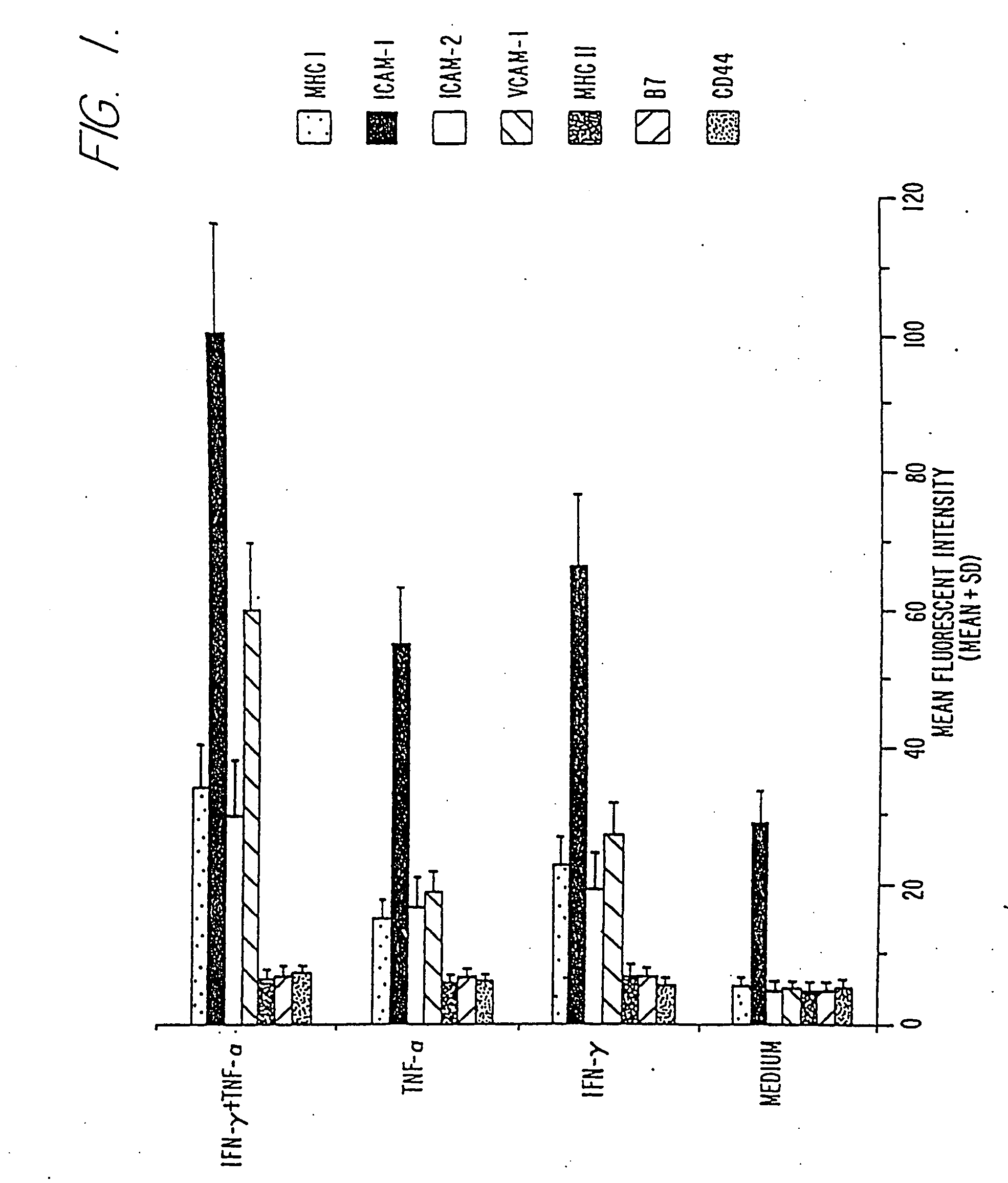Cellular vaccines and immunotherapeutics and methods for their preparation
a cell vaccine and immunotherapy technology, applied in the field of cell vaccines and immunotherapy and methods for their preparation, can solve the problems of cytokines and adhesion molecules, cytokines and more complex events, and the recognition of mhc-bound antigens by t cell receptors is not sufficient for t cell activation, so as to avoid negative t cell signaling pathways, enhance immune response, and avoid negative effects on normal cells
- Summary
- Abstract
- Description
- Claims
- Application Information
AI Technical Summary
Benefits of technology
Problems solved by technology
Method used
Image
Examples
example 1
Cytokine Induced Expression of Adhesion and MHC Molecules on HEPA 1-6 cells In Vitro
[0088] Hepa 1-6 is a chemically induced hepatoma originating in a C57BL / 6 mouse (G. J. Darlington et al., 1980, J. Natl. Cancer Inst. 64: 809). Cells derived from this tumor grow rapidly and form subcutaneous nodules in syngeneic animals. Hepa 1-6 cells lack both MHC class I and B7 molecules on their cell surfaces and do not induce a host immune response even when transfected with genes encoding the B7-1 or B7-2 molecule.
[0089] The conditions and cytokines most optimal for the amplification of activation signals on hepa 1-6 cells were determined as follows. One ml of Hepa 1-6 cells was plated into 24 well tissue culture plates at a concentration of 2×106 cells / ml and incubated with either IFNγ, 100 U, or TNFα, 50 U, or a combination of IFNγ and TNFα at these same concentrations in complete RPMI-1640 medium supplemented with 10% fetal calf serum, 2 mM glutamine, 1× non-essential amino acid and 1 mM ...
example 2
Stimulation and Proliferation of Syngenic Splenic T-Cells Induced by Cytokine Treated HEPA 1-6 Cells and Anti-CD28 Bi-MAb In Vitro
[0093] The following example demonstrates that cytokine activated Hepa 1-6 cells in combination with Bi-MAbs to CD28 and tumor cell antigens stimulate proliferation of splenic T cells in vitro, indicating that such Bi-MAbs can provide a CD28 costimulatory signal. Four Bi-MAbs, CD28:gp55, CD28:gp95, CD28:gp115 and CD28:gp210, each with one binding specificity for the CD28 molecule on T cells and a second binding specificity for one of three glycoproteins expressed on tumor cell surfaces, were prepared and used as follows.
[0094] For preparation of Mabs and Bi-MAbs, Wistar rats were immunized with 2×107 Hepa 1-6 cells in CFA. Following three additional boosts with the same cells in ICFA over an 8 week period, spleen cells from immunized rats were fused with YB2 / 0 rat myelomas as previously described (J. Alan & T. Robin, in: Immunochemistry in Practice, Cha...
example 3
In vitro Cytotoxicity of CTLs Generated by Cytokine Treated HEPA 1-6 Tumor Cells in Combination with Anti-CD28 Bi-MAbs
[0102] Cytotoxicity of CTLs generated by in vitro priming of naive splenic T cells with cytokine treated hepa 1-6 cells in combination with anti-CD28 Bi-MAbs or control MAb was established as follows. Nylon wool-enriched naive splenic T cells (5×106 / well) were first stimulated in vitro by incubation with 5×105 irradiated (5000 roentgens) cytokine treated hepa 1-6 cells (as described in Example 1) in combination with anti-CD28 Bi-MAbs, control antibodies or irradiated B7+hepa 1-6 alone at 37° C. for 9 days. γ-irradiated naive splenic cells (5×106) were added into cultures as feeder cells. At the 3rd and 6th day after stimulation, 2 ml of complete RPMI-1640 medium containing recombinant human IL-2 (20 U) were added into each culture well separately.
[0103] Cytotoxicity of CTLs toward syngeneic, allogenic tumor cells and a NK sensitive YAC-1 cell line was determined in...
PUM
| Property | Measurement | Unit |
|---|---|---|
| concentration | aaaaa | aaaaa |
| concentration | aaaaa | aaaaa |
| immunogenic composition | aaaaa | aaaaa |
Abstract
Description
Claims
Application Information
 Login to View More
Login to View More - R&D
- Intellectual Property
- Life Sciences
- Materials
- Tech Scout
- Unparalleled Data Quality
- Higher Quality Content
- 60% Fewer Hallucinations
Browse by: Latest US Patents, China's latest patents, Technical Efficacy Thesaurus, Application Domain, Technology Topic, Popular Technical Reports.
© 2025 PatSnap. All rights reserved.Legal|Privacy policy|Modern Slavery Act Transparency Statement|Sitemap|About US| Contact US: help@patsnap.com



